EXPORT SPOT X
PART I
In the first instalment of Export's Spot X series, we cover the year-round angling opportunities in the majestic Hauraki Gulf. We've done all the hard yards for you, so crack open a cold one and enjoy!
Proudly brought to you by
THE HAURAKI GULF


The location
Nestled between the North Island’s eastern coast and the Coromandel Peninsula, the Hauraki Gulf has long been a haven for fishing enthusiasts.
The Hauraki Gulf is an expansive body of water that lies between the Auckland region and the Coromandel Peninsula. It encompasses a network of islands, including iconic destinations such as Waiheke Island, Great Barrier Island, and Rangitoto Island.
The Hauraki Gulf features an incredible array of marine habitats and is home to a diverse range of flora and fauna, including dolphins, orcas, and Bryde’s whales. The Gulf is also a haven for seabirds, with colonies of gannets, terns, and petrels nesting on the islands. The marine biodiversity extends to the coastal areas, where expansive seagrass beds, rocky reefs, and kelp forests provide habitat for many fish species. The Gulf’s ecological importance has led to the establishment of marine reserves and sustainability initiatives aimed at preserving its delicate balance from environmental degradation and overfishing.
The all-weather angling options afforded by its myriad islands and sheltered bays, combined with handy access from Auckland, make the Gulf a popular and productive fishing destination. The Hauraki Gulf fishery changes considerably throughout the year, so it makes sense to discuss the fishing opportunities according to the four seasons.
Summer
While the weather is hot, fishing can sometimes be challenging over summer in the Gulf, particularly for snapper which become rather lethargic with the high water temperatures. A good tactic if you’re after snapper is to target the change of light periods when the fish feed harder. Also, drop down your leader and bait/lure sizes – this can make a big difference with finicky summer snapper. A handy rule of thumb is to use the smallest lure or weight that the current or drift conditions allow.
Summer is the best time of year to fish close to Auckland city for snapper – when you see the old charter boats parking up under the Harbour Bridge you can be sure the snapper are running up the Waitemata! Bait fishing or working softbaits or kaburas in areas such as the Chelsea Factory, Harbour Bridge, Stanley Bay, the container wharves, Motuihe Channel, Rangitoto Channel, Rangitoto shoreline, Administration Bay, between Rakino and Waiheke, East Coast Bays and northern Whangaparaoa should yield good results. If you’re lure fishing in these harbour environs, slow your action down due to the murky water – simply dragging lures along the bottom with the rod in the holder can be the most effective tactic (even though that’s a little boring!). Surfcasting along the city breakwalls and beaches can also yield surprisingly good snapper catches over summer and into autumn.
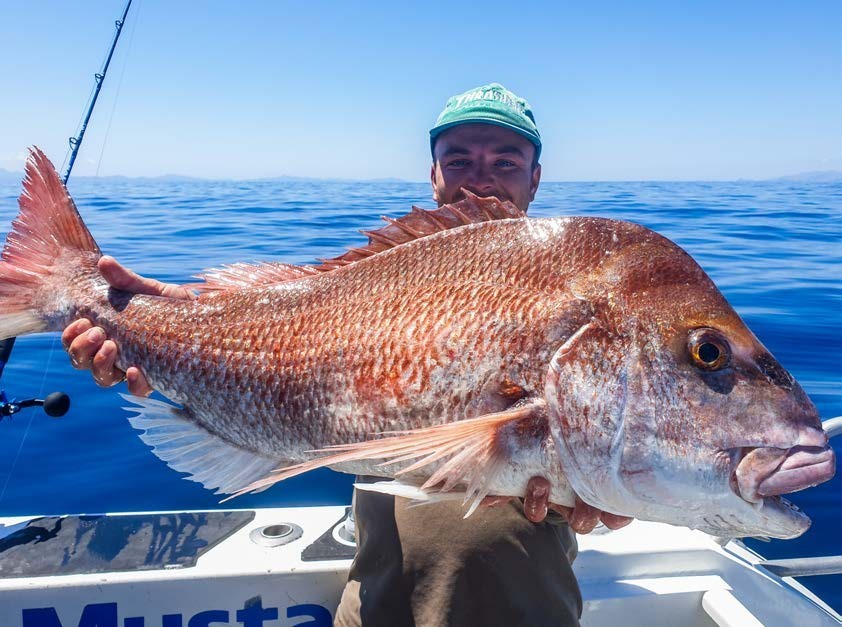
George Kittow with a moocher that inhaled a jack mackerel bait by Little Barrier Island.
Perhaps the most exciting species to turn up in numbers over summer are kingfish. Packs of fish invade classic areas like Anchorite Rock, Channel Island, Horn Rock, Flat Rock, and Shearers Rock. Aside from the well-known reefs, there are literally hundreds of spots where you can find kingfish in the Hauraki Gulf over summer – a quick perusal of the chart will show endless shallow reefs, headlands, and marker buoys and poles. Topwater lures and jigs are popular methods employed, but often the best way to catch kingfish throughout the day is with the real deal – livebait! Mackerel schools are generally not too hard to find through summer in the Gulf – typical areas to start looking are over the sand in 15–25m depths around the inner islands.
Watch your sounder for mid-water schools or find some terns working the surface and drop down the sabikis. When you find the bigger mackerel schools, there are often kingfish in attendance, too – so have a livebait set ready to go if you see some big slugs on the sounder or baits start getting plucked from your sabikis. If you’re overnighting on the boat, you should be able to catch jack mackerel at night from your anchored boat in most bays around the Gulf.
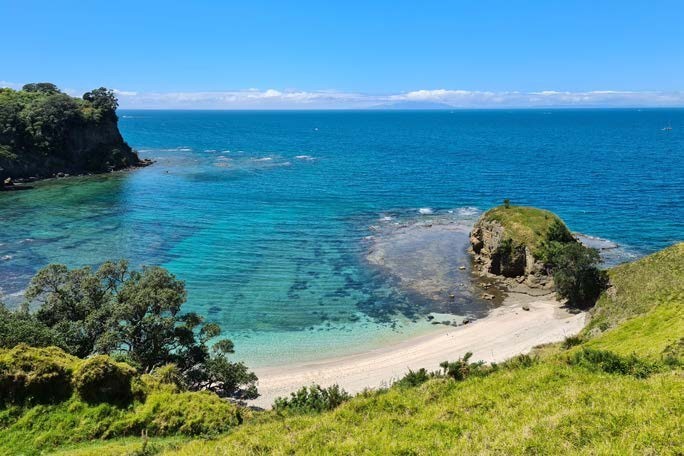
There are plenty of cool nooks and crannies for summer exploration in the Hauraki Gulf.
On the deeper reefs in the outer Hauraki Gulf there are other species around that are also suckers for livies – so don’t be surprised if your baby kingfish materialises into a decent snapper or john dory at the boat!

Kingfish turn up in numbers over summer in spots such as Anchorite Rock.
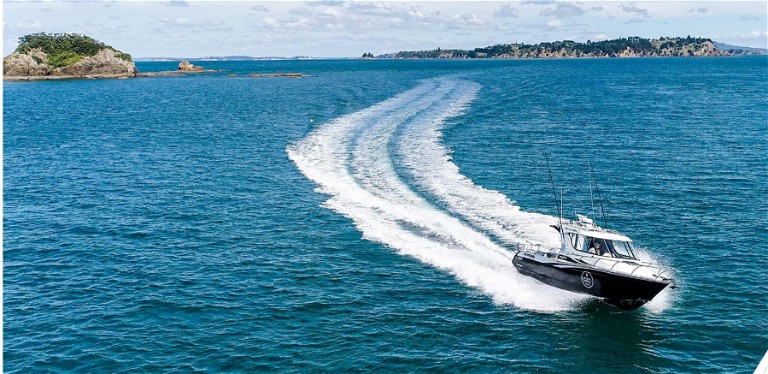
The Gulf is a boating and fishing playground.
Autumn
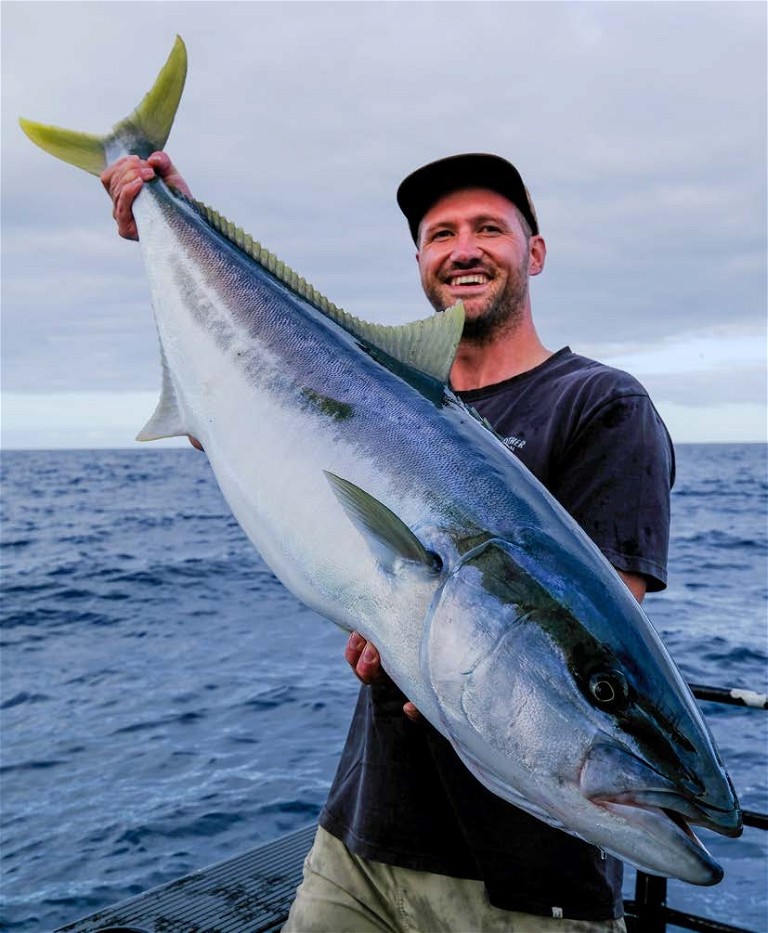
Decent kingfish test the mettle of anglers around the Hauraki Gulf reefs right through autumn.
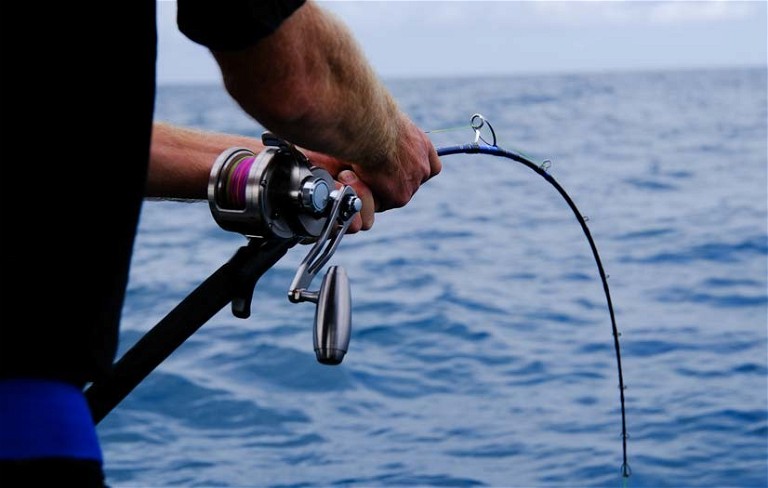
The end of summer generally signals the start of an exciting couple of months for the inshore Hauraki Gulf fisher. Snapper begin feeding harder, kingfish are around in good numbers, and the Gulf lays on a veritable banquet for such predators in the form of masses of anchovies. Anchovies are a small silver baitfish species that form dense schools. Their numbers seem to peak around late summer and autumn, and then tail off into winter. As a small fish, averaging around 5-10cm, they make perfect fodder for a variety of bird, mammal, and fish species in the Gulf.
Typical inshore locations to find anchovy action include the Rangitoto Channel, northern Rangitoto, Administration Bay, East Coast Bays, inside Kawau Island, Motuihe Channel, south of the David Rocks and Maria Island, Tamaki Strait, and the bottom end of Waiheke. Anchovy schools aren’t hard to stumble across as a variety of bird species generally give away their presence.
Squawking terns, shearwaters, gannets, gulls, shags, and little blue penguins can all be good indicators. Fishing the anchovy schools can be amazing one day, and an exercise in frustration the next. Some believe this is simply due to the sheer quantity of food available for predatory fish species.
The best approach for targeting the fat kahawai around the anchovy action is to match the hatch and concentrate on fishing near the surface. Lightly weighted small 3-5” softbaits in silver or blue, microjigs, or flies are your best bet to nab a couple for the smoker or fresh sashimi.
Snapper are generally a trickier proposition to pluck from the anchovy schools than kahawai. As snapper will be feeding on both live anchovies and ‘leftovers’ drifting down the water column, softbaits and microjigs are great options. Cast these out and let them sink with occasional twitches, then work them back along the bottom. If you’re having issues getting past the kahawai, try casting around the fringes of the surface activity or use heavier weighted jig-heads. You can even catch a few anchovies for bait on very small sabiki rigs, or if you’re lucky enough you can scoop them up directly from a meatball with a finemesh net. A little wriggling anchovy dropped to the bottom is dynamite for snapper.
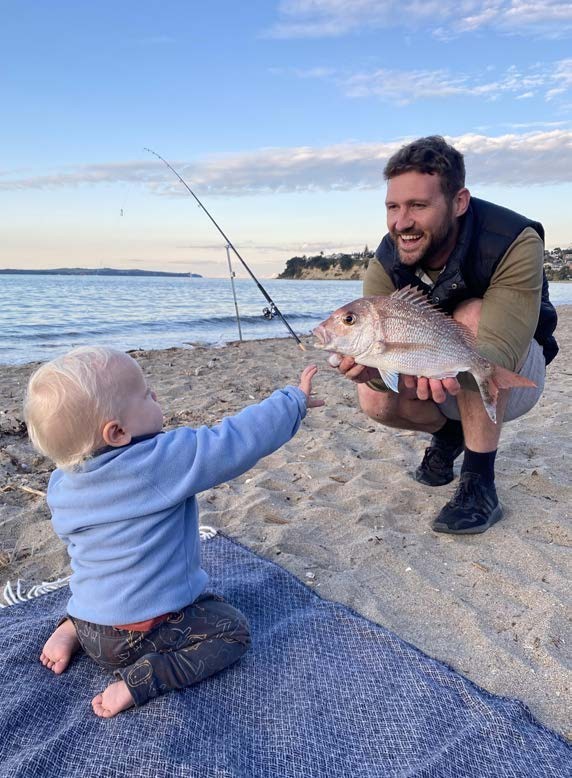
Surfcasting along Auckland’s city breakwalls and beaches can yield surprisingly good pannie snapper catches into autumn.
Kingfish also love taking advantage of the anchovy feast. Although the greenbacks feed on anchovies, they also gorge on the jack mackerel and pilchards that prey on the anchovies themselves. Livebaiting or having a stickbait ready to go when the kings pack attack bait on the surface can deliver plenty of fun.
Over autumn, workup action can be hit and miss out wider, although patches of snapper will start congregating in typical areas such as north of Gannet Rock, top of Coromandel, around Anchorite Rock, and east of Kawau Island. Fishing the 40-50m depths on the western side of Great Barrier Island can be insane this time of year, with plenty of kingfish and dolphins rounding up the bait and hungry snapper hanging around underneath. All you need are a few gannets working or even sitting on the water and you should be in for a good session.
Autumn is also a great time of year to target a species not often associated with the Hauraki Gulf – skipjack tuna. These fish come in surprisingly close to the islands and people often mistake them for kahawai when they’re feeding on the surface. The best techniques are to use very small baitfish imitations because these fish feed on small prey and seem to ‘get their eye in’ only on similar size lures. These fish are arguably even better light sportfish than kahawai – with blistering runs and super-fast tail beats. They also make good eating if prepared accordingly.
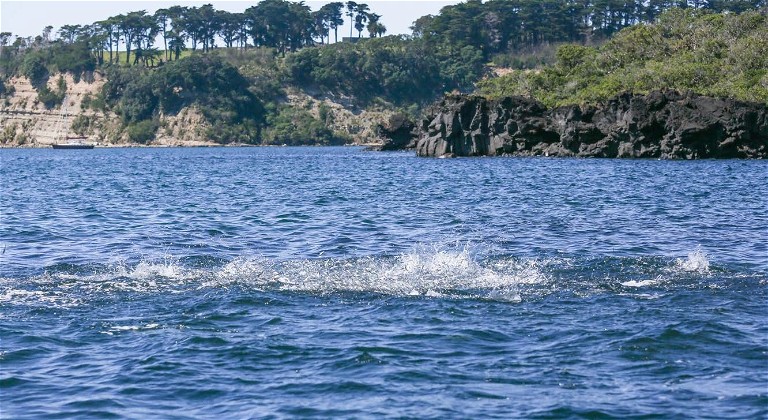
Autumn heralds the influx of huge anchovy schools into the Gulf’s inshore areas, providing exciting angling opportunities.
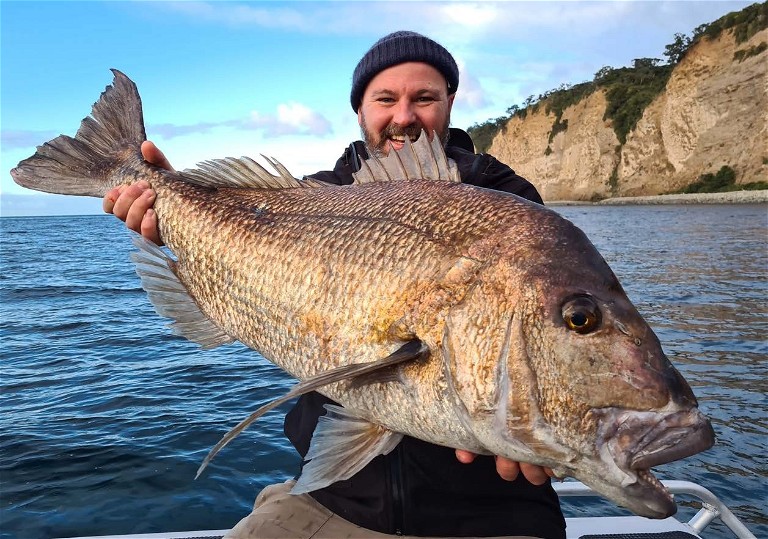
Winter is the best time to lurk around the coast and islands casting softbaits into the shallows, or parked up straylining a big berley trail, hoping to fool a big gnarly moocher.
Winter
Many anglers lay the fishing gear down over winter, but there is a smorgasbord of angling options over the cool season in the Gulf. Winter is the best time to lurk around the coast and islands casting softbaits into the shallows, or parked up straylining a big berley trail, hoping to fool a big gnarly moocher. Stunningly scenic and productive areas include the entire coastline of Little and Great Barrier islands, the Mokohinaus, around Fletchers Bay at the top of Coromandel, the back of Kawau Island and Tawharanui, and the northern side of Waiheke. Using large softbaits, like 7” jerkshads, will help entice the bigger fish out of their lairs and experiment with different colour schemes.
If, however, you’re more interested in quantity over quality, winter is a good time to set up long drifts with sliders and slowjigs and target the schools of snapper that accumulate around the 50m+ depth areas of the Gulf such as north of Anchorite Rock, off Fantail Bay, between Little Barrier and Great Barrier, and east of Kawau Island. There is also regular and sometimes intense workup action through winter. This action often concentrates on pilchard schools entering the Craddock, Jellicoe and/or Colville Channel areas.
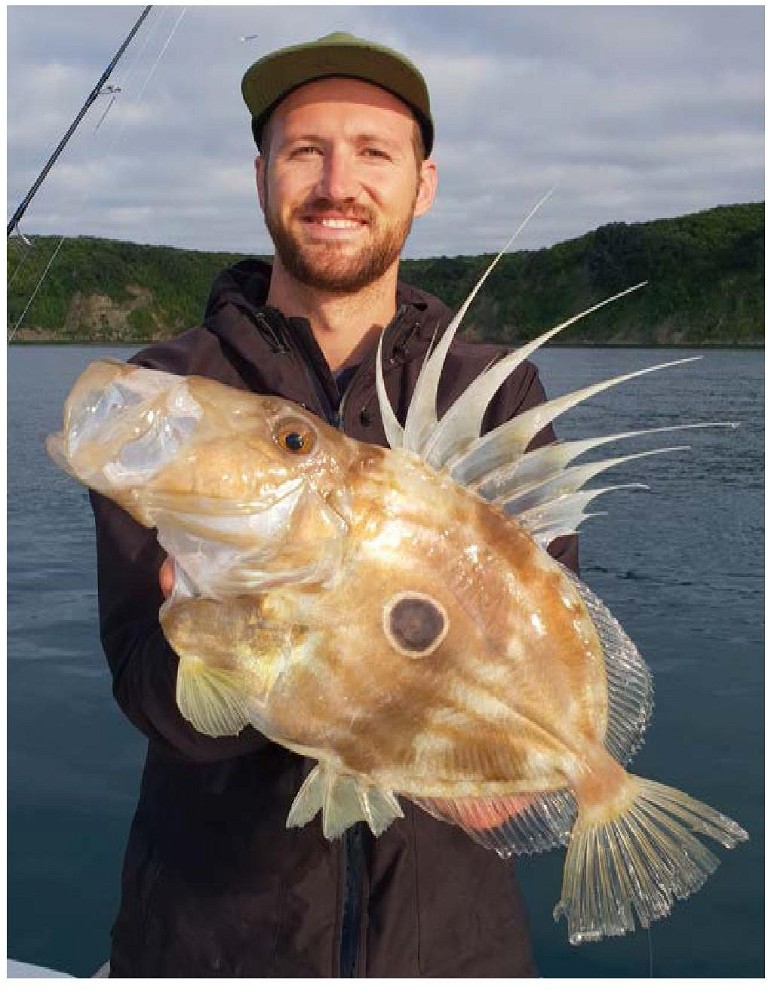
John dory are a delicious species to target over the cooler period.
It’s true that the majority of kingies move out of the Hauraki Gulf for winter, although you can still encounter the odd thug cruising around inshore. However, the outer Gulf – think top of the Coromandel, Great Barrier and the Mokohinaus – can really turn it on with larger-thanaverage greenbacks. Good techniques include early morning topwater, slow-trolling big livebaits (especially if you can find koheru to deploy), or stumbling into schools of kings smashing pilchards.
Winter is a great time to target a few different species that move inshore during the cooler months. Squid are accessible to all anglers, as they can be caught day and night from shore or boat all around the Gulf and Waitemata Harbour. While the dark hours are a very effective time to catch them, especially around the city shoreline and wharves under artificial light, they can be fooled during the day around sheltered rocky and weedy shorelines. The duller, natural-coloured jigs tend to work better during the day, and a general rule of thumb is to use smaller jigs earlier in winter to match the size of squid early in the season.
Aside from cephalopods, some other epic species are more readily available in the Hauraki Gulf over winter. Good numbers of john dory move into the reefs and, although regularly caught with lures such as softbaits, are suckers for a live jack mackerel deployed close to the bottom. Good areas to find the JDs include Flat Rock, Kawau Island, Ti Point, Leigh Reef, and Little Barrier. Trevally also make their presence felt as the water cools and make a great bycatch species when using small lures or cut baits. And we can’t forget the delicious gurnard —whilst definitely not a sportfish, they put up a decent tug on light gear with their distinctive rhythmic tail beats. Areas to find a good carrot patch as they move into shallower zones for winter spawning are sandy areas of the Gulf over shellfish beds, particularly out from beaches, in 10-25m of water. Old-school ledger rigs adorned with small shellfish or skipjack tuna baits in combination with some berley attached to the anchor chain work well, and sometimes it takes a while for the gurnard to congregate so don’t give up on a spot too soon.
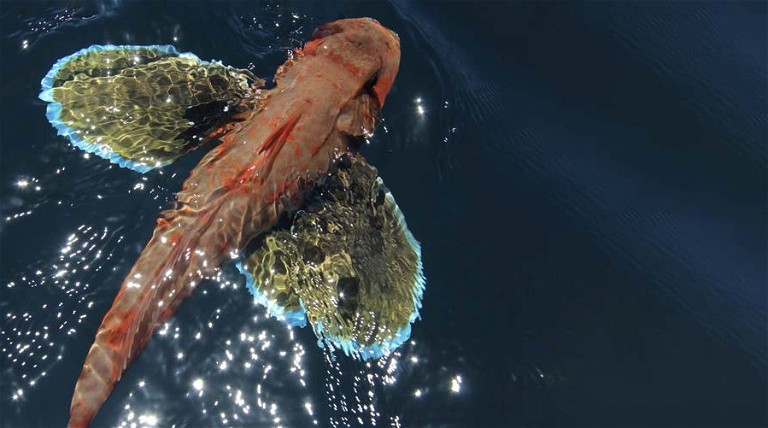
Winter gurnard numbers have been increasing over recent years in the Hauraki Gulf.
“ ...THE DELICIOUS GURNARD — WHILST DEFINITELY NOT A SPORTFISH, THEY PUT UP A DECENT TUG ON LIGHT GEAR WITH THEIR DISTINCTIVE RHYTHMIC TAIL BEATS. ”
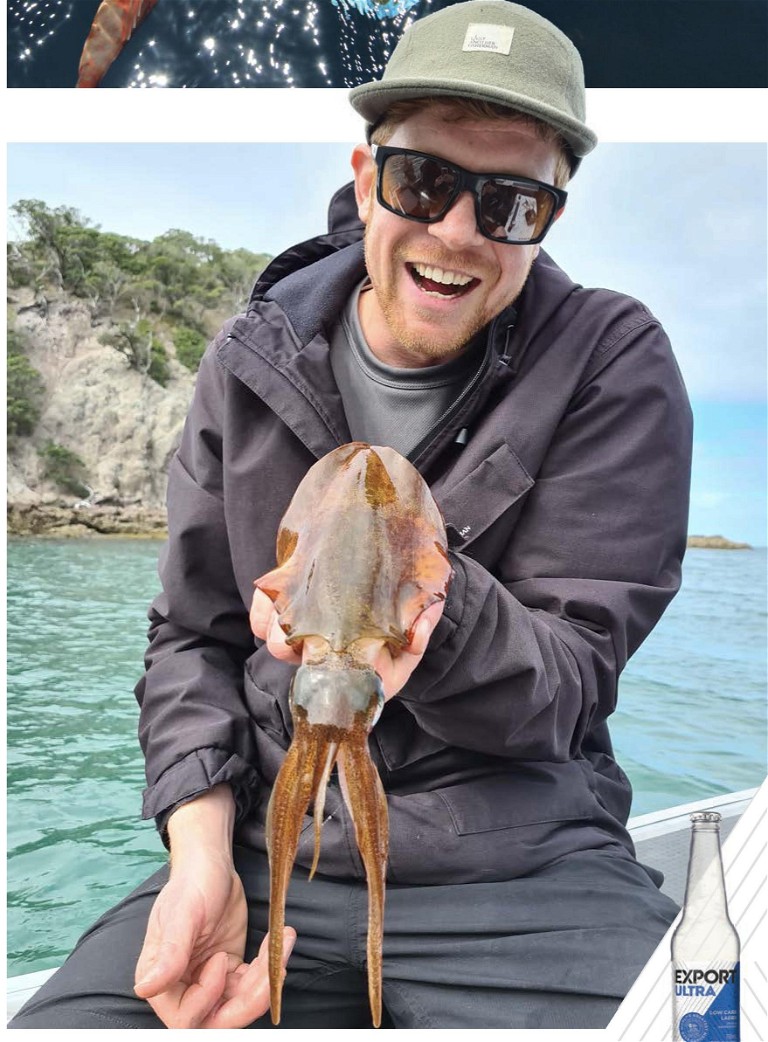
Squid are accessible to all anglers, as they can be caught day and night from shore or boat all around the Gulf and Waitemata Harbour.
Spring
Most of the Gulf fishing excitement in spring revolves around workups and the movement of big spawning snapper inshore. To make the most of your trip, you really need to consider the factors influencing whether the fish will be on the chew or not. Dolphins, gannets, and fish tend to be more active when the tide is running, and there’s a general trend for activity to intensify in the days leading up to both the new and the full moon. But beware, the fishing can sometimes be horrendous right on the new or especially the full moon – a mysterious wonder of the fishing world!
Many anglers also swear by Bite Times – most of which reflect the Solunar Calendar which considers the moon’s position relative to the earth. In the Hauraki Gulf, the Solunar Bite Time begins two hours before low tide. You can check them out here: https://www. fishing.net.nz/fishing-advice/bite-times/
But the most important thing is knowing where the action is happening. Spread out your feelers into your online, work, and personal connections, and be particularly wary of online reports that may be inflated or outdated!
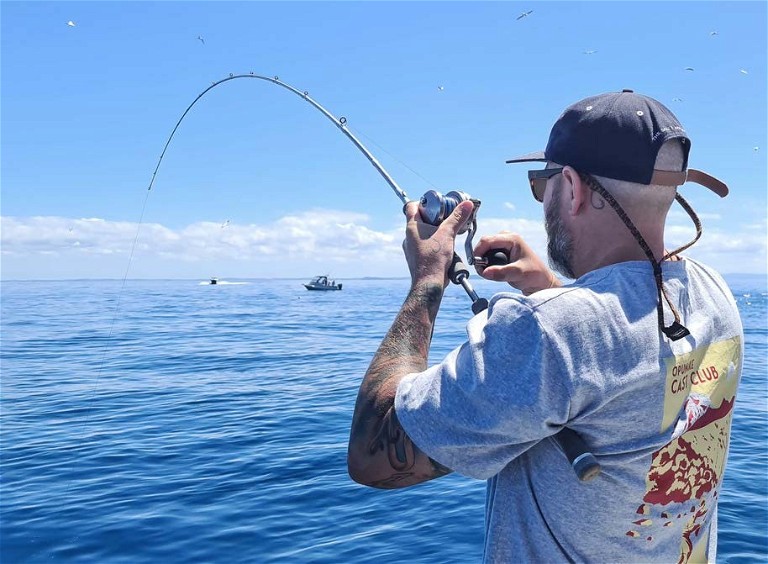
Most of the Gulf fishing excitement in spring revolves around workups and the movement of big spawning snapper inshore.
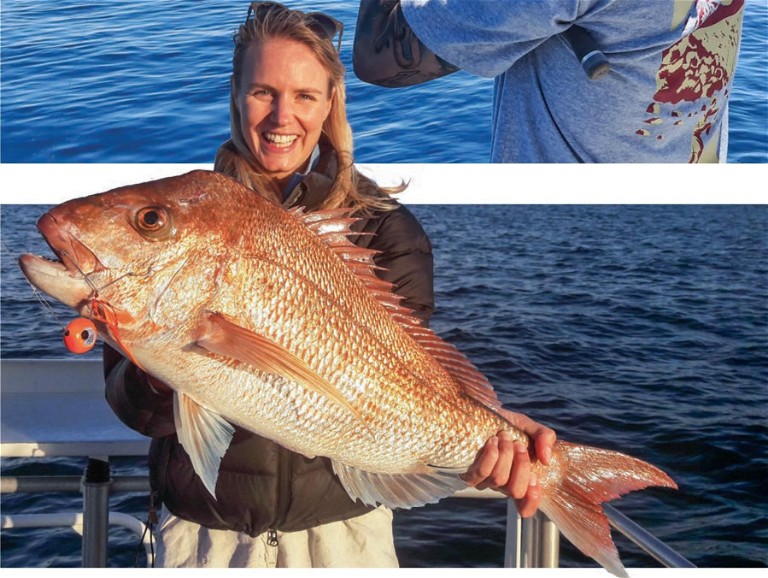
Brooke Jones with a beauty off Tiritiri Matangi Island.
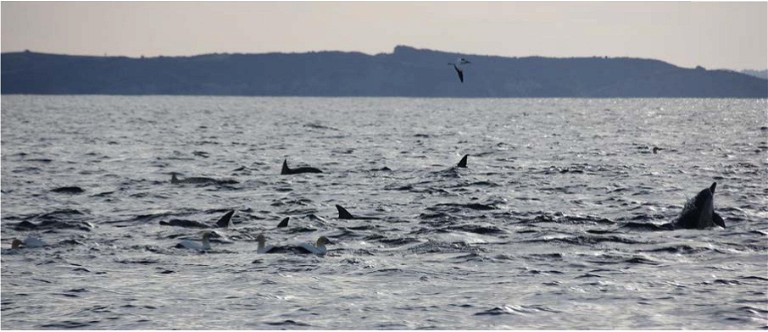
Dolphins work in tandem with gannets and are a welcome sight.
Obviously, to find the workups on the day you must find the gannets. Through spring they feed in workups daily because the survival of their fledglings depends on it. Generally, you will find most birds heading in a similar direction and they will lead you to action sooner or later. If the birds are high in the air and circling that means they’ve found some bait or some dolphins, whereas if they are flying low to the water in a straight line, they have seen some action and are using their precious energy to get there as quickly as possible. However, if they are flying in a winding path they may just be cruising, and following them can lead to an eye-watering fuel bill!
Dolphins work in tandem with gannets and are a welcome sight. Similarly, Bryde’s whales, of which around 50 seasonally reside in the Hauraki Gulf, are a telltale sign that you’re in the right area. Binoculars are a very useful tool for finding distant workups, and if you’re fortunate enough to have a bird radar on your vessel… well, crack yourself an Export because you’re working smarter, not harder! If you can’t find any surface action or birds feeding, don’t fret as there will still be fish down there, so set up long drifts and be patient. And if that doesn’t work for you, maybe consider giving up and going for a raft-up at Motuihe!
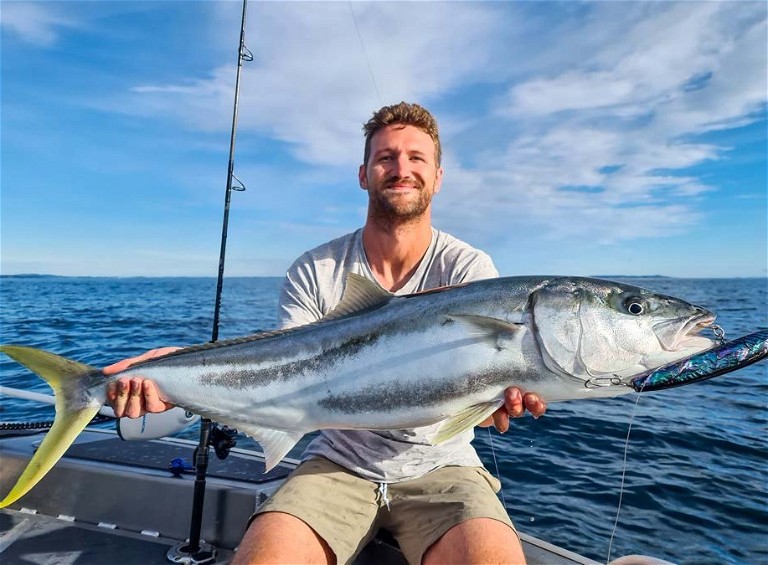
Flat Rock is a good spot to find kingfish at the end of spring.

Keen anglers get ready for dawn topwater casting missions in late spring.
The general trend is that the action will move closer to the city and intensify until early December. By summer the workups fizzle out as the pilchard schools have been decimated by predators and the snapper focus on something way more fun… procreation!
We hope you’ve enjoyed this crash course in fishing the Hauraki Gulf. Keep your eyes peeled for the next instalment of Export’s Spot X in an upcoming issue, where we will unearth another amazing Kiwi fishing destination.